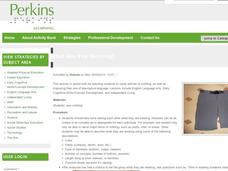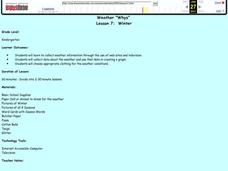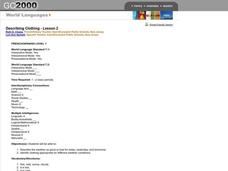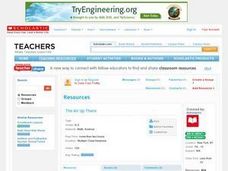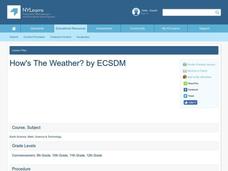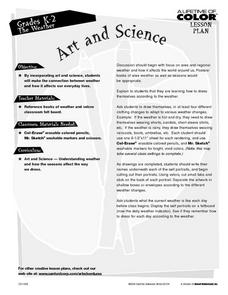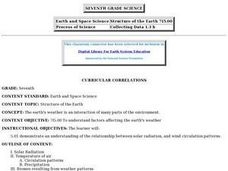Curated OER
Home Living / Daily Living: Dressing for the Weather
What to wear? Help your special needs class make independent choices about what they should wear during various weather conditions. They'll discuss weather-appropriate clothing, dress dolls for the weather outside, and even put on a...
Curated OER
Lesson 6: Mittens, Socks, Mittens, Socks, Mittens!
Mittens and socks, two of my favorite clothing items! Young learners with special needs, explore clothing appropriate for cold weather. They identify both socks and mittens, discuss weather appropriate clothing, and listen to the...
Virginia Department of Education
Weather Patterns and Seasonal Changes
Get your class outside to observe their surroundings with a lesson highlighting weather patterns and seasonal changes. First, learners take a weather walk to survey how the weather affects animals, people, plants, and trees during...
Perkins School for the Blind
Learning Names of Articles of Clothing
What to wear today; such a vexing question. Spend some time introducing the names, fabrics, types, colors, and functions of various articles of clothing to your class. Each child will take turns asking each other what they are wearing....
Curated OER
Matter
Second graders read the book The Mitten and discuss the changing weather and appropriate clothes to wear in certain kinds of weather. In this weather lesson plan, 2nd graders also have a literature, writing, and math component to the...
Curated OER
Weather "Why"
Students research weather and explore how to use their research information. In this weather information lesson, students visit a given website for weather forecasts. Students graph the weather, sing weather songs and select a class...
Curated OER
Weather "Whys"
Students complete activities to explore fall weather. In this weather lesson plan, students use the given links to examine weather forecasts. Students complete a weather graph activity and watch Internet field trips. Students complete...
Curated OER
Weather "Whys"
Students explore the weather. In this weather data lesson, students collect weather data from Internet and media sources. Students graph the collected data discuss it as well as the seasons of the year.
Curated OER
Quel temps fait-il?
Hit all the basics with this lesson plan, focusing on weather, greetings, and dates! Start by singing a weather related song ("Quel temps fait-il by Barbara MacArthur is suggested), and then read a story about getting ready for school....
Curated OER
Froggy Gets Dressed
Froggy wants to know: what are you wearing? Lead young Spanish learners through a review of weather-related terms before reading the popular children's book Froggy Gets Dressed. Then, using a froggy puppet, discuss what you're...
Curated OER
What Do I Wear in the Winter?
Students identify the appropriate clothing to wear in the winter. For this seasonal weather lesson, students discuss what warm and cold weather feels like and what clothing is necessary during the specific seasons. Students explore...
Curated OER
Weather "Whys" Lesson 4: Spring
Students explore the attributes of spring. In this weather lesson, students collect data regarding weather from various media. Students graph simple weather data and dress animals for forecasted weather. Students discuss the...
Curated OER
Weather Awareness
Second graders investigate weather. In this weather lesson, 2nd graders discover how to read a temperature gauge, keep track of the weather, and find out how the weather affects their day. They work individually and in partners to make...
Curated OER
"Weather" or Not?
Students complete a three week unit about weather and how it affects our behavior. They read and discuss various books related to weather, conduct an experiment about the tilt of the earth, plan a field trip based on temperature,...
Curated OER
What's the Weather?
Second graders make daily weather observations, record them with appropriate stickers on a chart, and then summarize them at the end of the week in the form of a bar graph.
Curated OER
Using the Engineering Design Process to Dress for the Weather
Students study weather and define the appropriate dress for various weather patterns. In this weather and clothing instructional activity, students discuss wearing appropriate clothes for specific weather. Students use the weather board...
Curated OER
The Air Up There
Students observe the weather over a period of two weeks. They gather local weather data and calculate the mean and average figures from the data. They prepare a graph with their observations.
Curated OER
How's the Weather?
Students explore earth science by researching the Internet. In this weather pattern lesson, students utilize the website weather.com to analyze the weather in different geographic locations. Students view charts and graphs based on...
Curated OER
Dressing for the Season
Students discuss what types of clothing to wear for the different seasons. They dress a paper doll every morning based on the weather outside. They also discuss what is a typical day in each of the different seasons.
Curated OER
The Weather
Students, by incorporating art and science, make the connection between weather and how it affects our everyday lives.
Curated OER
Hypothermia: Temperature Changes Under Varying Conditions
Students conduct an experiment to determine what type of clothing would be most suitable for outdoor activities. They determine the temperature changes of the skin under various wet clothing materials and graph the temperature changes. ...
Curated OER
Art and Science: Weather
Learners examine how weather affects daily life. They draw pictures of themselves wearing clothing appropriate for four different weather conditions. They display their drawings each day according to the weather conditions.
Curated OER
Earth's Weather
Seventh graders learn how solar radiation, latitude, and other factors affect weather. They break into six groups and are assigned a topic to research and to present their findings orally.
Curated OER
The Air Up There
In this data collection and analysis lesson, learners observe and graph the weather conditions during one school week, then calculate the average weather temperature. Extensions are included.



